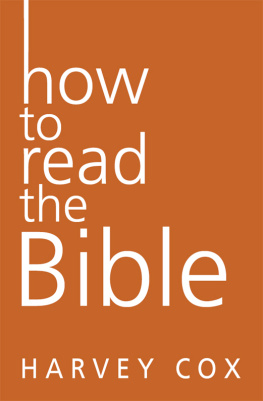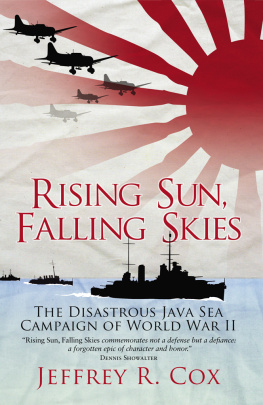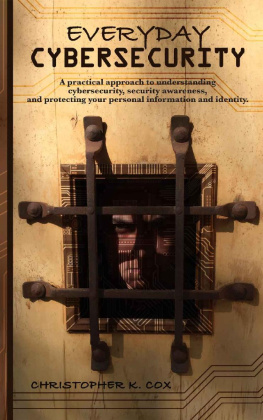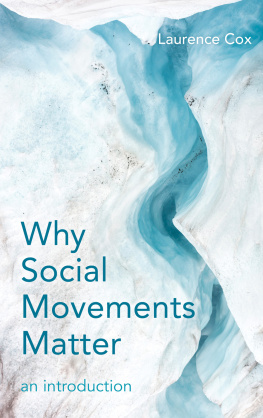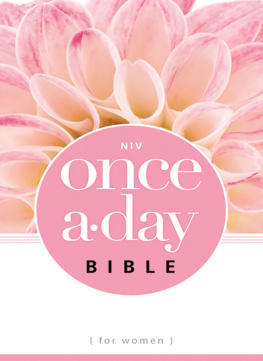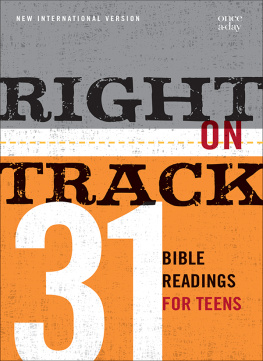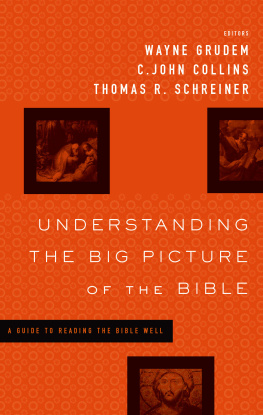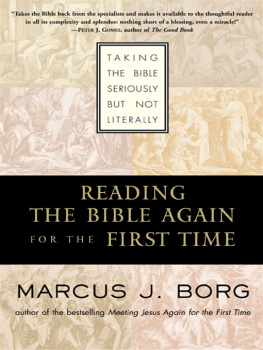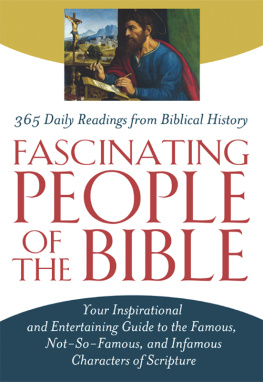This book is dedicated to all the
friends, preachers, teachers, priests and nuns,
colleagues, professors, students, and scholars, pastors,
believers and atheists, writers, poets, and filmmakers,
who have in countless ways helped me to appreciate the Bible.
In particular I dedicate it to the memory of
my teacher, colleague, dean, and personal friend:
Krister Stendahl (19212008)
Contents
- Serpents, Floods, and the Mystery of Evil:
The Book of Genesis - Following the Footsteps of Moses:
The Book of Exodus - Battles and Burlesques in the Conquest of Canaan:
The Book of Joshua - Talking Back to God from the Garbage Heap:
The Book of Job - Listening to the Voices of the Voiceless:
Amos and the Prophets - Getting to the Final Four:
Gospels, Kept and Discarded - Looking Over the Shoulders of the Writers:
Matthew, Mark, and Luke - On the Road with Paul of Tarsus:
The Epistles - Surviving a Turbulent Trip:
The Book of Revelation
Guide
I did not grow up in the Bible Belt. My parents were only occasional churchgoers. I never saw either one of them pick up a Bible, let alone read it. Nonetheless, I was born, as many of us were, in a Bible-drenched country. Take, for example, the movies I went to on Saturday afternoons: King of Kings, The Robe, and of course The Ten Commandments, among many others. The one that sticks in my mind most was Samson and Delilah, featuring Victor Mature and Hedy Lamarr, which suffused the biblical epic with an erotic quality sure to stir the glands of an adolescent boy. But I also knew the Bible was serious stuff. It was the volume witnesses placed their hand on to swear an oath. Soldiers reported they had been saved from death by the New Testament they carried in their breast pocket. In Protestant America, with its historic aversion to idols, the Bible was the only universally recognized sacred icon. In a sense the whole of America was a Bible belt, although how much people knew about what was in the Bible was another matter.
At some point I did discover that there was in fact a Bible, a large one, in our home. Covered with dust, it lay at the bottom of a set of shelves containing several volumes of the old brown- and gold-bound Colliers Encyclopedia. No one ever opened the Bible or, as far as I can remember, the encyclopedia either. But one day, driven by curiosity rather than piety, I looked inside the Bible. It contained some colorful pictures of people who appeared to be wearing bathrobes and towels. Gold margins bordered the first chapters of some of the books. But, looking through it, I soon discovered that for our family its main function was to serve as an archive for the dates of births, marriages, and deaths of previous generations, inscribed in different colored ink, some of it now fading, in a section just before the book of Genesis.
I think of my personal history with the Bible as unfolding in three stages, each with its own way of reading it. The first stage I call the narrative stage. Like many people, I simply took the Bible at face value and more or less literally, although even as a youngster I had my doubts about some of the accounts that seemed improbable. The second phase of my evolving understanding of the Bible might be called the historical one. It began when I was in college and continued through seminary and beyond. In this period my emphasis was on the context in which a particular biblical book was written, for and to whom, when and why. The third stage, which has been developing slowly during my adult years, I would like to call the spiritual stage. I do not, however, mean spiritual in a narrow or merely inward sense, but in a holistic one that includes inner and outer, personal and social. I will have more to say about all these modes in the rest of this book.
In retrospect I do not believe these three stagesthe narrative, the historical, the spiritualor the manner of studying the Bible each implies can be sharply differentiated. Just as we all carry features of earlier stages in our psychological development with us as we grow older, all of these ways of grasping the Bible remain part of my repertoire. But I believe they need to supplement and complement each other in order to get the most from any reading of biblical texts. This is something I attempt to do throughout this book.
THE NARRATIVE STAGE
As a child, along with my siblings, I was dutifully dispatched to the Baptist Sunday school next door to our home by my religiously indifferent parents, in part to keep up appearances, but alsoI suspectto get us out of the house, so they could savor a second cup of coffee and peruse the Philadelphia Inquirer. Seated in Sunday school on hard wooden chairs under the tutelage of a series of well-intentioned but only sketchily informed lay teachers, I heard the stories of the Bible. I found them fascinating, if frequently not quite credible. There was the nasty fight between Cain and Abel. And there was the aforementioned Delilah, who entrapped a muscular Samson with her sultry charms. There was Noah and his menagerie aboard the ark. I especially liked the one about David, the cheeky little kid who slew the big bully. And there were also all those stories Jesus toldthe parablesand the ones people told about him.
We did not just hear these stories. We also sometimes acted them out. As a child I often pulled on a bathrobe, wrapped a towel around my head, and gripped a stick in my hand as a character in a Nativity play (We have seen a star in the East...). When as a teenager I began to attend church, mostly to sing in the choir, I always noticed the huge black leather Bible that lay open on the varnished pulpit, its gold edges glistening and its purple page marker dangling. It was the biggest book I had ever seen, so I knew it must be important. Sometimes the preacher read from it, but more often he read from a much smaller one placed on top of the big one. What little I remember about the sermons I heard from that pulpit is that they were made up mainly of anecdotes and allegories intended to illustrate the points the preacher was making. Years later I still remember many of these illustrations, but hardly any of the points they were supposed to dramatize. For a kid in a church that had no formal creeds, the Bible was not a handbook of doctrines. It was a compendium of stories, and for that I am grateful.
Those were the days before the U.S. Supreme Court ruled that the practice of reading the Bible in public schools was unconstitutional. Consequently, I heard the Bible read every day for years. At that time state law mandated that ten verses of the Bible be read aloud, but without commentary, so that is exactly what our teachers, and later the students selected for the task, did. What we heard 90 percent of the time were Psalms from the King James Version: Lift up your heads, O ye gates; even lift them up, ye everlasting doors; and the King of glory shall come in (24:9). I liked the cadence of the words, but what king was entering and where those gates were were never explained. Still, it is remarkable how, after so many years, those verses still resonate through my synapses. If at Sunday school I encountered the Bible mainly as stories, in the public school it spoke to me primarily as poetry.
In my teens I became more involved with our small church, was elected president of the youth group, and as such was even invited to preach once when the pastor (along with nearly everyone else in the congregation) was on vacation. As a high-school student and as I began to read the Bible on my own, I began to realize that, as endearing as the stories I was learning were, they represented only a carefully culled sample drawn from many more, some of them apparently deemed not suitable for Sunday school, such as the ones about Noahs drunken nakedness or the prostitute who concealed Joshuas spies. It also occurred to me that the laypeople who taught us had no inkling and, maybe no curiosity, about when and why any of these stories were first told. In short, the story stage of my introduction to the Bible was also largely a literal stage.

